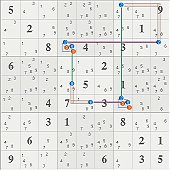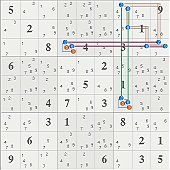Thank-you StrmCkr for a very interesting puzzle. After the excellent move above, I found another rather interesting move.
SAM
1) ssts
2) (2)r6c7=-r1c7-r3c9=(2-6)r3c4=r3c89-r12c7=(6)r6c7 loop =>r6c7,r3c4<>59
3) (5sf)r3c68,r6c82,r7c26 => r28c6,r4c28<>5
as noted above gets us to this point
- Code: Select all
*-----------------------------------------------------------------------------*
| 5 34 167 | 238 23678 178 | 2467 478 9 |
| 34 2 679 | 3589 36789 789 | 4567 1 478 |
| 17 179 8 | 26 4 1579 | 3 567 267 |
|-------------------------+-------------------------+-------------------------|
| 6 13789 1579 | 489 189 2 | 4579 4789 3478 |
| 2378 3789 279 | 4689 5 489 | 1 46789 234678 |
| 128 1589 4 | 7 1689 3 | 26 589 28 |
|-------------------------+-------------------------+-------------------------|
| 247 457 3 | 1 279 4579 | 8 4679 467 |
| 478 6 57 | 34589 3789 4789 | 479 2 1 |
| 9 1478 127 | 248 278 6 | 47 3 5 |
*-----------------------------------------------------------------------------*
4) [[(9):r3c6=r3c2-r2c3=r4c3]=(9-2)r5c3=(2-1)r9c3=[(1):r4c3=r1c3-r3c12=r3c6]]=> (19)r3c6=(19)r4c3 => (19)r3c6=(19-5)r4c3=(5)r8c3-r7c2=(5)r7c6 => r3c6<>5 (of course, one could just as easily eliminate (5)r4c3) => some singles.
step as a pigeonhole matrix (each column except first is a wis, each row a sis, nxn matrix =>conclusion is first column is a sis) (also, sis are labelled to the far left of matrix for clarity) => r3c6<>5
- Code: Select all
5r7 c6 c2
5c3 r8 r4
1c3 r4 r9 r1
1r3 c6 c12
2c3 r9 r5
9c3 r4 r5 r2
9r3 c6 c2
In any event, whatever we will call the first step involving the loop in candidates 26, this step contains an almost almost loop of the same variety involving candidates 19. Call it 2 degrees of freedom. The 2s is column 3 subtract one degree of freedom. This leaves the 5's with too little freedom to exist at both of the two loop endpoints, r3c6 and r4c3.
A shorter view of the same elimination: (uses one less sis)
(5)r7c6=(5)r7c2-(5=7)r8c3-(7)r12c3=[(1)r3c6=(1)r3c12-(1=6)r1c3-(6=9)r2c3-(9)r3c2=(9)r3c6 loop] =>r3c6<>5
With this view, the Almost Hub rim 2 spokes has one degree of freedom in the rim, AALS 1679 r12c3. The beginning of the chain above shows where that one degree of freedom might lead.
Below, find a pigeonhole matrix that describes the shorter view:
- Code: Select all
5r7 c6 c2
r8c3 5 7
r2c3 7 6 9
r1c3 7 6 1
1r3 c6 c12
9r3 c6 c2



